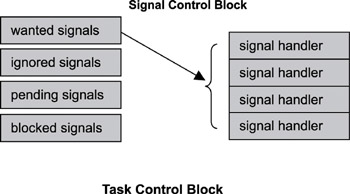Книга: Real-Time Concepts for Embedded Systems
8.4.1 Signal Control Blocks
8.4.1 Signal Control Blocks
If the underlying kernel provides a signal facility, it creates the signal control block as part of the task control block as shown in Figure 8.11.

Figure 8.11: Signal control block.
The signal control block maintains a set of signals-the wanted signals-which the task is prepared to handle. When a task is prepared to handle a signal, it is often said, “the task is ready to catch the signal.” When a signal interrupts a task, it is often said, “the signal is raised to the task.” The task can provide a signal handler for each signal to be processed, or it can execute a default handler that the kernel provides. It is possible to have a single handler for multiple types of signals.
Signals can be ignored, made pending, processed (handled), or blocked.
The signals to be ignored by the task are maintained in the ignored signals set. Any signal in this set does not interrupt the task.
Other signals can arrive while the task is in the midst of processing another signal. The additional signal arrivals are kept in the pending signals set. The signals in this set are raised to the task as soon as the task completes processing the previous signal. The pending signals set is a subset of the wanted signals set.
To process a particular signal, either the task-supplied signal handler can be used for signal processing or the default handler supplied by the underlying kernel can be used to process it. It is also possible for the task to process the signal first and then pass it on for additional processing by the default handler.
A fourth kind of response to a signal is possible. In this case, a task does not ignore the signal but blocks the signal from delivery during certain stages of the task’s execution when it is critical that the task not be interrupted.
Blocking a signal is similar to the concept of entering a critical section, discussed in Chapter 15. The task can instruct the kernel to block certain signals by setting the blocked signals set. The kernel does not deliver any signal from this set until that signal is cleared from the set.
- 8.4 Signals
- 8.4.2 Typical Signal Operations
- 15.6.2 Asynchronous Event Notification Using Signals
- LOCK SIGNAL
- Introduction to Microprocessors and Microcontrollers
- Data sending and control session
- Data Binding Using the GridView Control
- Configure Access Control
- Using the kill Command to Control Processes
- 3.4.4. Concurrency Control
- Controlling Services at Boot with Administrative Tools
- Basic Shell Control




